INDIGENOUS PIG BREEDS
| Ghungroo | North Bengal |
| Niang Megha | Meghalaya |
| Agonda Goan | Goa |
| Tenyi Vo | Nagaland |
| Nicobari | Nicobar island |
| Doom | Assam |
| Tirupathi Varaha | Andhra Pradesh |
| Zovawk | Mizoram |
| Ghurrah | Uttar Pradesh |
| Mali | Tripura |
| Purnea | Bihar and Jharkhand |
| Banda | Jharkhand |
| Wak Chambil | Meghalaya |
| Andamani | Andaman & Nicobar |
GHUNGAROO
NIANG MEGHA
AGONDA GOAN
TENYI VO
NICOBARI
DOOM
TIRUPATHI VARAHA
MANIPURI BLACK
BANDA PIG
WAKCHAMBIL
ANDAMANI PIG
ZOVAK
GHURRAH
MALI
PURNEA
GHUNGAROO
GHUNGAROO
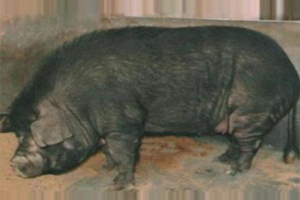
- High prolificacy and ability to sustain in low input system.
- Produces high quality pork utilizing agricultural by-products and kitchen wastes.
- These pigs are predominantly black, occasionally displaying white hooves and metapodials.
- They are characterized by a broad, flattened face and a short, upwardly curved snout.
- Their large, pendulous, heart-shaped ears resemble elephant ears, making them easily identifiable.
- Ghoongroo pigs have a distinctive bulldog-like facial appearance. The litter size ranges from 8 to 18 piglets
NIANG MEGHA
NIANG MEGHA
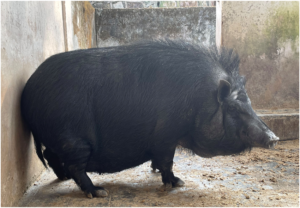
- These pigs found mostly in the Khasi, Garo and Jayantia mountain of Meghalaya state.
- The colour of this pig is generally black but star shaped white at forehead and hock joint may present.
- The Snout is medium tapering partially white at nostril, Bristle is long on midline and uniformly at other places. The animals have typical wild look with erect bristles on dorsal midline and small erect ears extended vertically. Niang Megha is the second registered pig breed in the national database
- Reared for pork and bristle purpose.
AGONDA GOAN
AGONDA GOAN

- This breed is found in the Tiswadi, Bardez, and Pernem regions of the North Goa district, as well as the Mormugao, Canacona, and Quepem talukas of the South Goa district.
- The animals are small, featuring short ears, a short snout, a pot belly, and a wild nature with rough bristles.
- While the predominant colour is black, some animals exhibit white patches on their legs and face.
- They are known for being very furious and alert. The large-sized Agonda Goan pig is preferred by locals for its meat, especially during marriages and other festivals.
- People prefer these animals for sausage making.
TENYI VO
TENYI VO
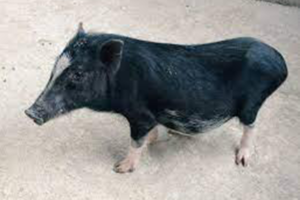
- The Tenyi Vo pig, also known as Votho, Naga Local, or Suho, has breeding tract primarily in the Kohima, Phek, and Dimapur districts of Nagaland.
- This breed is named after the Tenyimia communities, including Angami, Rengma, Chakesang, and Zealiang, who are responsible for its breeding.
- The Tenyi Vo pig is raised mainly for pork production in Nagaland. These pigs are characterized by a long, strong, tapering snout, small erect ears, and bright, alert eyes.
- Adult pigs typically weigh between 36 kg and 50 kg, with an average adult body weight of 40 kg. At 10 months old, their average weight is recorded as 24.57±0.31 kg.
- The Tenyi Vo pig is mostly black in color, with both sexes exhibiting this trait. They have a pot-bellied appearance, with females having a sagging back and pendulous belly that touches the ground.
- Other distinctive features include a straight tail ending with a white switch reaching the hock joint, white stockings, and white markings on the forehead and ventral body.
NICOBARI
NICOBARI
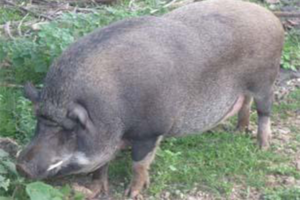
- The Nicobari pig, indigenous to the Nicobar Islands, has been reared by the Nicobari tribes since ancient times.
- Found primarily in the Nicobar District of the Andaman & Nicobar Islands, this breed is also known as Ha-un or Naut, meaning “pig” in the local Nicobari language.
- Nicobari pigs are mostly black and brown, with some pigs exhibiting creamy-white, reddish-brown, or mixed black and brown colours.
- They have a sturdy, short, and long body, with a medium to short snout and short erect ears.
- A marked bristle crest (mane) extends from mid-head/shoulder to the base of the tail.
- Their facial profile ranges from flat to concave, and they have a short neck with a very large jowl.
- The tail is notable for its lack of curling. Nicobari pigs are ferocious in nature and have an average adult body weight of 63 kg.
- Semi-feral in nature and no systematic management is followed by the tribes.
DOOM
DOOM
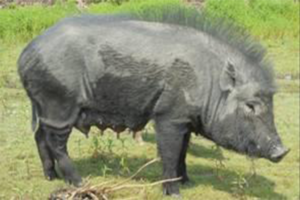
- The Doom pig, indigenous to Assam, is named after the local ‘Doom’ community, which has been rearing these pigs for generations.
- Found in the Dhubri, Bongaigaon, and Kokrajhar districts of Assam, Doom pigs are black in colour and have a short, concave snout.
- The meat of Doom pigs is lean and highly palatable, fetching a higher price in the market.
- These pigs are adapted to a migratory scavenging system, requiring minimal inputs.
- Farmers often move their pigs from place to place in search of food, and some provide housing using low-cost, locally available materials.
- Doom pigs have a large, flat-bellied body type, short erect ears, and a straight topline with long bristles extending to the thoraco-lumbar area.
TIRUPATHI VARAHA
TIRUPATHI VARAHA

- It is the new cross-bred pig which suits the agro-climatic conditions of Andhra Pradesh.
- It is the product of cross breeding between indigenous pigs and Large White Yorkshire (LWY) for efficiency of feed conversion, production and reproduction.
- Average litter size is 8 and weight at slaughter: 80kgs.
MANIPURI BLACK
MANIPURI BLACK
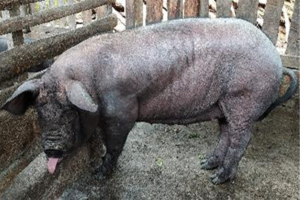
- It is a native pig breed of Manipur state, mainly reared for meat.
- These medium-sized pigs are predominantly black, although grayish-black body coats and white patches on the extremities can also be seen.
- They have a medium-sized, concave, dish-shaped head, a short slightly upward-curved snout, a well-built long body with short legs, and a prominent neck.
- Both males and females are covered with short hair.
- Adult males have an average body weight of about 96 kg while females weigh around 93 kg.
- Litter size ranges from 6 to 11 piglets and meat is preferred by local people for its taste.
BANDA PIG
BANDA PIG
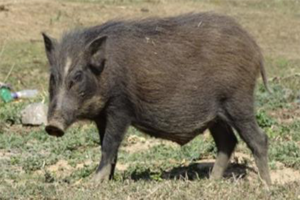
- It is a native breed of Jharkhand, mainly reared for pork and manure.
- These pigs are black coloured, having short and erect ear. These pigs have a long and concave snout, medium to short bristle on neck.
- The average adult body weight is 28.0 kg in male and 27.0 kg in females and litter size ranges from 4 to 7.
- Banda is small sized pig, with typical ‘wild look’ and highly ferocious. Coat colour is mainly black or dark grey.
- Distinguishing features included body covered with thick hair, specially on poll and neck, small but elongated snout, small erect ears.
- Also having specific burrowing nature.
- These physical conformation traits are true breed characters and do not match with any of the recognised indigenous pig breed.
- The pork is leaner and tastier and highly preferred for its taste by local people.
WAKCHAMBIL
WAKCHAMBIL
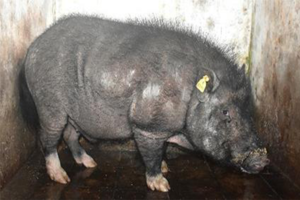
- These pigs are small, predominantly black and white in colour, and possess well-built, compact body structures with short limbs.
- They have small heads, small eyes, medium snouts, small erect ears, and small hooves that touch the ground less frequently.
- It is a small-sized pig breed with a round and pendulous belly.
- It is mainly distributed in the Garo Hills of Meghalaya.
- The pork from Wakchambil pigs is known for its unique flavour and taste and is cherished during religious and ceremonial occasions by local people.
- The average adult body weight is around 32 kg in males.
- Litter size at birth ranges from 4 to 11 piglets.
ANDAMANI PIG
ANDAMANI PIG
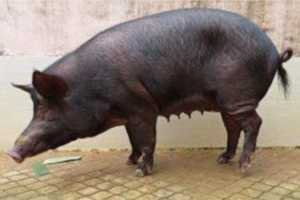
- It is a native breed of Andaman group of islands.
- They are sturdy and medium in size and black (mostly) or rusty gray in colour.
- They are fast runners and evolved to thrive under low-input management system & mainly reared for pork purpose.
- Average adult body weight for male is 71 kg and for female is 68 kg.
ZOVAK
ZOVAK
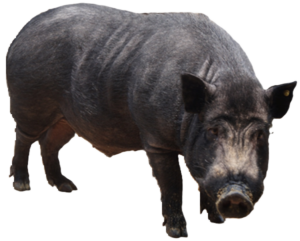
- The Zovawk pig, also known as Mizo local, has breeding tract in the Aizawl, Lunglei, Lawngtlai, Champhai, Saiha, and Kolasib districts of Mizoram.
- The meat from this pig is highly preferred by locals. The name ‘Zovawk’ comes from the Mizo language, where ‘Zo’ means Mizo and ‘vawk’ means pig.
- This breed is well adapted to hilly regions. Zovawk pigs are predominantly black with a white spot on the forehead (star) and occasionally have white patches on the belly and white boots.
- They have distinctive erect ears, a concave snout, a pot belly, a concave top line, and long bristles along the mid-line.
- The average body weight is 32.27±0.87 kg at 8 month of age while adult weighs 50 Kg.
- Zovawk pigs are social animals, rarely staying alone under normal conditions.
- Historically, they foraged for food in groups and slept together, usually scavenging in and around houses and forest areas, and sleeping under houses in a head-to-tail arrangement.
- These pigs communicate through specific grunting sounds to indicate food, warn of danger, or call their young ones.
- In the face of danger, the leader emits a loud grunt, causing the group to huddle together in a circle with their snouts outward and the weaker and younger pigs in the centre.
GHURRAH
GHURRAH
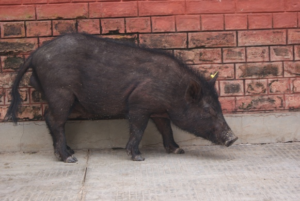
- These pigs are native to the Bareilly division and adjoining parts of the Lucknow division in Uttar Pradesh.
- Also known as Deshi or Bareilly Local, they produce a peculiar sound called “Ghur,” which is why they are named Ghurrah.
- These pigs are primarily black, though some are greyish-black or brownish. They are medium-sized with flat bellies, angular bodies, and long straight snouts.
- Their legs below the hock joint are white, and a thick line of hair runs from the neck to the shoulders.
- They have elongated heads with triangular faces and short, leaf-shaped, vertically erected ears.
- Adult male Ghurrah pigs weigh about 46 kg, while females weigh about 48 kg.
- The farmers prefer Ghurrah pigs for their disease resistance, hardiness, and adaptability to local conditions.
- These pigs can withstand dog attacks and protect their piglets without harm.
MALI
MALI
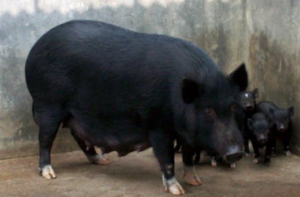
- The Mali pig is native to the Dhalai and North districts of Tripura.
- These pigs are generally black with star-shaped white patches on their foreheads.
- They are medium-sized with pot bellies and medium to small bristles distributed throughout their bodies.
- Mali pigs are characterized by their short, erect ears lying perpendicular to the body axis and a concave snout.
- Sows typically come into heat soon after weaning. Mali pigs are usually sold at the age of about 1 to 1.5 years, with a market weight of about 70 kg.
PURNEA
PURNEA
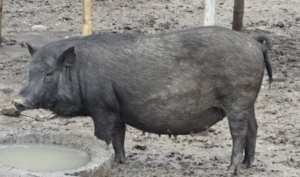
- Purnea is the first registered pig breed from Bihar and Jharkhand.
- This black-coloured, medium-sized pig is primarily found in the Purnea and Katihar districts of Bihar and the adjoining areas of the Sahibganj district in Jharkhand.
- Purnea pigs have compact bodies and pot bellies, with some individuals displaying white spots on their lower limbs.
- A thick line of bristles runs along the top line from the neck to the shoulders, giving the pigs a wild appearance.
- These pigs are characterized by round faces, short conical and erect ears, and small, thick, slightly concave snouts.
- Their skin is thick, with neck folds in mature animals, and they have a ferocious nature.
